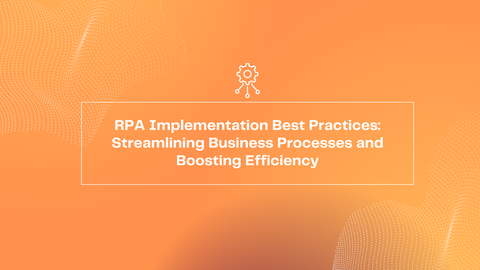In today's fast-paced business landscape, organizations are constantly seeking ways to improve efficiency and reduce operational costs.
Robotic Process Automation (RPA) has emerged as a powerful solution to help businesses achieve these goals.
RPA enables the automation of repetitive, rule-based tasks, freeing up human resources to focus on more strategic and creative activities.
However, successful RPA implementation requires a thoughtful and well-planned approach. In this blog post, we'll explore the best practices for implementing RPA effectively.

Define Clear Objectives
The first step in any RPA implementation project is to define clear and achievable objectives. What specific tasks or processes are you looking to automate?
What are the expected benefits, such as reduced error rates, increased efficiency, or cost savings? Clearly outlining your goals is essential to measuring the success of your RPA implementation.
Choose the Right Processes
Not all processes are suitable for automation. To maximize the benefits of RPA, start by identifying tasks that are repetitive, rule-based, and time-consuming.
Look for processes that involve high data volumes and standard operating procedures. These are the low-hanging fruits that RPA can handle most effectively.
Select the Right RPA Tool
Selecting the right RPA tool is crucial for success. There are many RPA software solutions available, each with its unique features and capabilities.
Consider factors like ease of use, scalability, security, and integration capabilities when choosing the tool that best fits your organization's needs.
Involve Stakeholders from the Beginning
Involving stakeholders from different departments in the planning and implementation process is essential.
This ensures that everyone's needs and concerns are taken into account. RPA can impact various teams, including IT, finance, HR, and operations, so their input is invaluable.
Build a Skilled RPA Team
Having a skilled RPA team is crucial for a successful implementation. This team should consist of individuals who understand both the technology and the processes they are automating.
Training and upskilling your team will also be necessary to keep up with the evolving RPA landscape.
Pilot Projects and Testing
Before rolling out RPA across the organization, it's wise to start with pilot projects. This allows you to test the RPA solution in a controlled environment and identify any potential issues.
Thorough testing and fine-tuning are essential to ensure that the automation works as expected.
Security and Compliance
Security and compliance should always be a top priority in RPA implementations. Ensure that your RPA solution meets all security standards and compliance regulations relevant to your industry.
This includes data protection, access control, and audit trails.
Monitor and Measure Performance
Once your RPA solution is up and running, continuous monitoring and performance measurement are essential. Use key performance indicators (KPIs) to track the impact of automation on your business processes.
This data will help you make adjustments and improvements as needed.
Plan for Scalability
As your organization grows, the demand for automation is likely to increase. Plan for scalability from the beginning, and choose an RPA tool that can grow with your needs.
Scalability ensures that your automation efforts can adapt to your business's changing requirements.
Provide Ongoing Training and Support
RPA technology evolves rapidly, so it's crucial to provide ongoing training and support to your RPA team.
This will help them stay up to date with the latest developments and best practices, ensuring that your automation efforts continue to be successful.
Conclusion
Robotic Process Automation is a powerful tool that can transform the way your organization operates. By following these best practices, you can streamline your business processes, reduce operational costs, and improve efficiency.
Successful RPA implementation starts with clear objectives, the right tools, and a dedicated team. Over time, it can lead to significant improvements in productivity and competitiveness.
If you're considering RPA for your organization, remember that a well-structured implementation strategy is key to reaping the full benefits of this transformative technology. Ready to transform your business with RPA?
Contact us to get started on the path to efficiency and growth.
